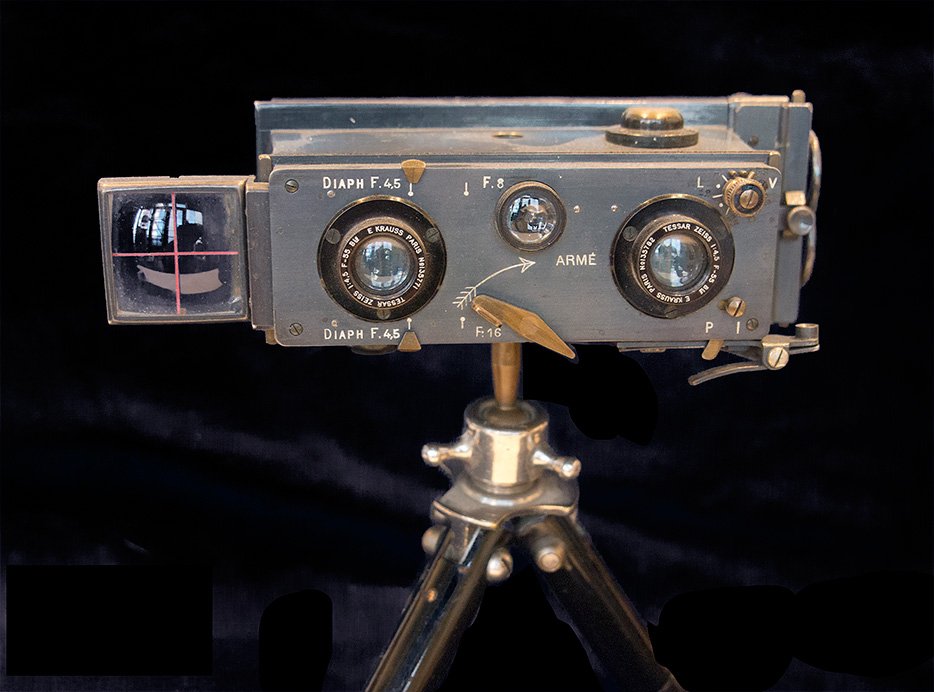Cameras
Miniature and Subminiature Cameras
Perhaps because I don’t like carrying things in my hands or in bags slung over my shoulder, miniature cameras have always appealed to me. The patriarch of the subminiature must have been the Minox, conceived in the late 1920s, and invented in the 1930s by a Latvian craftsman, Walter Zapp. He developed and improved the tiny Minox that became the prototypical “Spy” camera of the Second World War and into the cold war of the mid 1900s. Minox used a special 9.5 mm film that available in readily insertable cassettes. Perhaps most unique of the subminiatures is the Tessina, developed in 1956. It was more square in shape but used 35mm film respooled to fit the camera and could be readily concealed in a cigarette pack. Except for the Olympus Pen-F and the Jules Richard Verascope, each of the cameras exhibited here will easily fit into a shirt or jacket pocket.
Minox IIIs, (Model A in Europe) , 1950s
Minox, Model B, Black, w Light Meter after 1958
Tessina, 35 mm Twin Lens Reflex, 1956
Tessina From Front and Top Views
Rollei A110, 110 Casette Film
Pentax Auto 110, Single Lens Reflex with Split Image focusing on 110 film.
Rollei 35s, Full Frame 35mm Film
Olympus 35AE, Full Frame 35mm, Closed.
Olympus AE, Full Frame 35mm, Open
Original Olympus PEN-F, 35mm Film Half Frame Single Lens Reflex, 1963
Goldi by Zeh, Dresden, Folding Camera, 3x4 cm Images on 127 film. ca 1930
Minox EC, Closed and Open, Received as the Prize for "Best in Show." Minox Historical Soc. 2008, ("Lady on the Bridge," Platinum Print)
Stereo Cameras
Very early in the development of photography, photographers and viewers began to yearn for even more realism in the form of a three-dimensional or stereo view. Stereoscopy is achieved in human vision by the separation of the two eyes giving each a slight different view of an object. The visual cerebral cortex then fuses the two slightly disparate views within into a single but stereoscopic image. Similarly, a camera can also be made with two lens separated sufficiently to register two a similar, slightly different, views of the same object. These can then be simultaneously viewed enabling the viewer to “fuse” the two images into one stereoscopic view.
Coronet 3-D. 1953, 127 Film. Fixed Aperature and Shutter Speed-f18--1/50. Bakelite
Graflex Stereo Graphic. 1955, 35 mm Film. f4 Aperature, adjustable to f8.. Shutter, 1/50 or "Time"
Thornton-Pickard Stereo Puck Box Camera. 1931-1935. 120 Film
Jules Richard Stereo Verascope, ca 1921. Prob. Model 6Bs. f4.5, 8, & 16, Shutter 1/500-1/9
Special Interest Cameras
Most of these exhibited cameras hold some special interest to me and others also have a unique place in the history. Although the earliest camera often were box like in shape and construction, my interest in Box Cameras, lays with the small simple box cameras of the early 20th Century, such as the classical Kodak Brownie that began to be manufactured in the late 19th century. Portable, uncomplicated with easy to develop film, these early box cameras brought photography to the general public. I am particularly take with the mini box cameras that used 127 roll film and measured only a few inches on a side.
Argus A, 1936-1941. An early 35 mm American camera, made in Ann Arbor, Michigan, Sold at $12.50, and popularized the 35mm format in America. My first 35 mm camera.
Zeiss Contaflex Super. My first SLR. Uniquely coupled exposure meter and shutter speed upper right. 1959. Interchangeable front lens elements.
Zeiss Contaflex II. Originally owned by my father. Had an uncoupled light meter, upper right and a special bracket for telescopic lens attachments. 1954
Leica M3, Belonged to Bette’s father, Walter Lueck. Described as “World’s Greatest 35 mm Camera” (Ken rockwell.com). 1954.
Agfa Clack. Black Plastic Body, Fixed Focus Single element lens, 120 Rollfilm. 1954-1965
Kodak Signet 35. Kodak's most popular 35mm camera of 1950's with a coupled rangefinder. My wife, Bette's, first camera. 1951--1958.
Zero Image Pinhole camera. Wood w lovely brass fittings. 120 Rollfilm.
Graflex Speed Graphic Press Camera 4x5"; Belonged to My Wife's Uncle
Zeiss Ikonta 521/2. Folding Camera. 6x9 images on 120 Rollfilm. Novar 3.5/10.5 CM lens with Compur Shutter. Prewar, ca 1938.
No. 3A Folding Pocket Kodak, B3 Model, was a folding bed camera for making exposures in 3¼×5½ inch postcard format on type No. 122 rollfilm. 1903-1915
Century #7 Studio Camera, ca 1910
Century #7 with Minox A Camera on Table Beneath Century's Studio Lens
Brownie Hawkeye Camera, Flash Model 1950-1962. My first camera was this one, ca 1950. This one is a later issue with plastic winder knob.
Brownie Hawkeye out of the box.
Kodak Rainbow Hawkeye, #2, Model C, 120 Film. 1913 Red. (This camera was reissued in 1930 and given away to 12 year old children, but this one appears to be the 1913 version.)
Ensign All-Distance, Houghton-Butcher, Great Britain, Ltd. 120 Roll film. 1927
Likely a 1929 predecessor of Eho Box camera Model 152. 120 film
1931 Eho Box Camera, Model 152. This model has the internal close up lens and a cable shutter release.
Ansco Shur Shot, 127 Roll film, ca 1948
Zeiss Icon Baby Box Tengor 54/18, 127 Roll Film, ca 1932
Eho Altissa Baby Box Camera 3x4 cm. 127 Film. 1930, Dresden
Kodak No 0 Brownie Box Camera, 127 film Similar to "Baby Box" Cameras. Introduced 1914. Produced 1917-1928






































